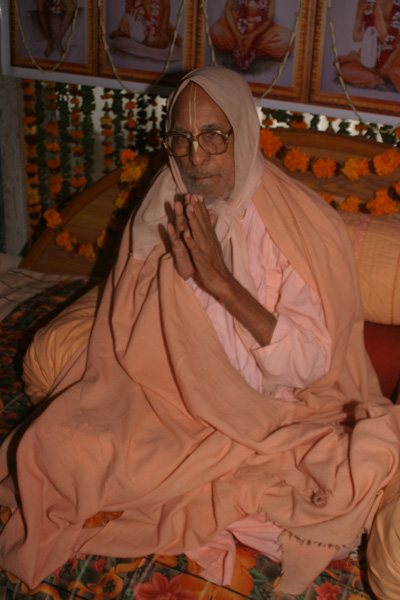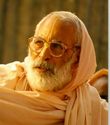

[Srila Narayana Maharaja held a three-day festival in Janakapuri, Delhi, from Nov. 19-21, and on the last day he installed the transcendental forms of Sri Sri Radha-Ramana-bihari, Sri Caitanya Mahaprabhu and Srila Bhaktiprajnana Kesava Gosvami Maharaja. During the installation ceremony he gave a discourse to the 1,500 guests, in Hindi, and the following is a transcription of the English translation:]
I have been traveling around the world, preaching Vedic culture. The Vedic teaching is that we are not this body. This body is made of bones and blood. We are eternal, but this body is perishable. All the worlds scientists and doctors cannot extend a persons life for even one second. In the heart of this body, we souls reside along with Paramatma, the Lords localized four-armed expansion. As a result of our forgetting the Supreme Lord, Sri Krsna, maya, the Lords deluding material potency, captured us in this world and gave us gross and subtle bodies. Since time immemorial we have been transmigrating from body to body, and this will go on until we are liberated. In this human form of life you must realize who you are.
Sri Valmiki chanted Hare Krsna under the guidance of Narada Rsi. Before chanting, he identified with his body, and he was a dacoit and a murderer. By Naradas mercy, Valmiki attained perfection by chanting the name of Rama. Ajamila was also very sinful, but he also attained perfection by chanting the Supreme Lords holy names.
Some people think that God is impersonal, with no form or qualities. But He is not formless. Some people think that when He comes to this world, He assumes a form, and this form is different from His true self. This is not true, either for Krsna or for Rama. Most people follow the impersonal philosophy of Sri Sankaracarya. The Muslims and Jains think God is formless, but they are wrong. The Buddhists do not believe in form, either for living beings or for the Supreme Godhead, but they are also wrong. The first teaching of the Bible is that God created man in His own image. G-O-D; God is the Generator, the Operator and the Destroyer. If He were not the embodiment of all powers, how would power be able to exist? It is written in the Muslim scripture Koran, "Inallah kalaka mein suratihi. Allah or Kudda has shape, and from that shape He fashioned man. Suratihi means "form".
You should know the law of cause and effect. If there is no cause, how can there be an effect? This is philosophy. If God has no form, how can we have form? In the mango seed there is form, otherwise how can the mango manifest a form? All potency is in the seed.
Today, we are installing the Deities, Sri Sri Radha-Ramana-bihari. If the devotee is pure, Krsna will not only accept his offering, but will speak to him. Srila Sanatana Gosvami was worshipping his Deity, Sri Madana-mohana. He was so poor that he could not even afford to put salt or butter on the chapatti he was offering. His deity, Lord Sri Krsna, said, Oh, no salt? My throat is dry and I wont be able to swallow this. Srila Sanatana Gosvami replied, That is all I have, you will have to accept it. Krsna had to accept it because it was offered by His devotee.
Another history of the divine reality of the deity is stated in Sri Caitanya-caritamrta: There were two brahmanas, one elderly and one young, and they both lived in a place called Vidyanagara. After touring many places of pilgrimage they reached Vrndavana. The elderly brahmana was very pleased with the service of the young brahmana, and he wanted to give him his youngest daughter in marriage. He made his offer in a temple, directly in front of the Gopala Deity of Vrndavana. The Gopala Deity thus became the witness. When both brahmanas returned to their residences in Vidyanagara, the younger brahmana brought up the subject of this marriage, but the elderly brahmana, due to obligations to his friends and wife who were totally against the idea, replied that he could not remember his promise. The younger brahmana returned to Vrndavana and narrated all the events to the deity Gopala. Obliged by the young man's devotional service, Gopala then accompanied him to South India. Gopala followed behind His devotee, who could hear the tinkling sound of Gopala's ankle bells. When all the respectable gentlemen of Vidyanagara were assembled, Gopala testified to the promise of the elderly brahmana and the marriage was thus performed. Later on, the King of that land constructed a beautiful temple for Gopala.
There is another history about Sri Gopalaji in the scriptures, in relation to Lord Jagannathas assisting King Purusottama-jana of Orissa. This king was insulted by the King of Kataka, who refused to give him his daughter in marriage and called him a sweeper of Lord Jagannatha in a derogatory way. With the help of Lord Jagannatha, (Sri Krsna and Balarama Themselves, who rode on horseback in front of the king
[-----------------------------------------------------------------------------------------------------]
Editorial Advisors: Sripad Madhava Maharaja and Sripad Brajanath dasa
Editor: Syamarani dasi
Transcriber: Anupama dasi
Typist: Anita dasi
HTML: Bhutabhavana dasa
![[BVML Home Page]](../../grfx/bml_logo.gif)
